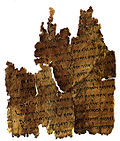Dead Sea Scrolls
Dead Sea Scrolls[edit]
The Dead Sea Scrolls are a collection of ancient Jewish texts discovered in the Qumran Caves near the Dead Sea in the West Bank. These scrolls have been of immense historical, religious, and linguistic significance, providing insight into the Second Temple period and the origins of Christianity.
Discovery[edit]
The scrolls were first discovered in 1947 by a Bedouin shepherd named Muhammad edh-Dhib. Over the next decade, further excavations in the area led to the discovery of eleven caves containing thousands of fragments from over 900 manuscripts. These texts are believed to have been written between the third century BCE and the first century CE.
Contents[edit]
The Dead Sea Scrolls include a wide variety of texts:
- Biblical Manuscripts: Approximately 40% of the scrolls are copies of texts from the Hebrew Bible. These include some of the oldest known copies of these texts, such as the Great Isaiah Scroll.
- Apocryphal and Pseudepigraphal Works: These are texts not included in the canonical Hebrew Bible, such as the Book of Enoch and the Book of Jubilees.
- Sectarian Manuscripts: These include texts that are believed to be unique to the Essenes, a Jewish sect that some scholars associate with the community at Qumran. Examples include the Community Rule and the War Scroll.
- Commentaries and Other Texts: The scrolls also contain commentaries on biblical texts, liturgical texts, and other writings.
Significance[edit]
The Dead Sea Scrolls are significant for several reasons:
- Textual Variants: They provide evidence of the textual variants that existed in the Hebrew Bible before the standardization of the Masoretic Text.
- Historical Context: The scrolls offer insights into the religious practices, beliefs, and social structures of Jewish groups during the Second Temple period.
- Early Christianity: Some of the texts have parallels with early Christian writings, shedding light on the religious environment from which Christianity emerged.
Preservation and Publication[edit]
The preservation of the scrolls has been a major concern since their discovery. Initially, the scrolls were kept in the Palestine Archaeological Museum (now the Rockefeller Museum) in East Jerusalem. After the Six-Day War in 1967, they came under the control of the Israel Antiquities Authority.
The publication of the scrolls has been a long and sometimes controversial process. Initially, access to the scrolls was restricted to a small group of scholars, but in the 1990s, the Huntington Library released photographs of the scrolls, leading to wider access and study.
See Also[edit]
References[edit]
- Schiffman, Lawrence H. Reclaiming the Dead Sea Scrolls. Jewish Publication Society, 1994.
- VanderKam, James C., and Peter Flint. The Meaning of the Dead Sea Scrolls. HarperSanFrancisco, 2002.
External Links[edit]
-
Psalms Scroll
-
Kumeran
-
Qumran
-
Jericho and Dead Sea area and River Jordan
-
Great Isaiah Scroll
-
The Damascus Document Scroll
-
Genesis 1 Dead Sea Scroll
-
7Q4
-
Temple Scroll
-
Dead Sea Scroll 175, complete, Testimonia
Ad. Transform your life with W8MD's Budget GLP-1 injections from $75


W8MD offers a medical weight loss program to lose weight in Philadelphia. Our physician-supervised medical weight loss provides:
- Weight loss injections in NYC (generic and brand names):
- Zepbound / Mounjaro, Wegovy / Ozempic, Saxenda
- Most insurances accepted or discounted self-pay rates. We will obtain insurance prior authorizations if needed.
- Generic GLP1 weight loss injections from $75 for the starting dose.
- Also offer prescription weight loss medications including Phentermine, Qsymia, Diethylpropion, Contrave etc.
NYC weight loss doctor appointmentsNYC weight loss doctor appointments
Start your NYC weight loss journey today at our NYC medical weight loss and Philadelphia medical weight loss clinics.
- Call 718-946-5500 to lose weight in NYC or for medical weight loss in Philadelphia 215-676-2334.
- Tags:NYC medical weight loss, Philadelphia lose weight Zepbound NYC, Budget GLP1 weight loss injections, Wegovy Philadelphia, Wegovy NYC, Philadelphia medical weight loss, Brookly weight loss and Wegovy NYC
|
WikiMD's Wellness Encyclopedia |
| Let Food Be Thy Medicine Medicine Thy Food - Hippocrates |
Medical Disclaimer: WikiMD is not a substitute for professional medical advice. The information on WikiMD is provided as an information resource only, may be incorrect, outdated or misleading, and is not to be used or relied on for any diagnostic or treatment purposes. Please consult your health care provider before making any healthcare decisions or for guidance about a specific medical condition. WikiMD expressly disclaims responsibility, and shall have no liability, for any damages, loss, injury, or liability whatsoever suffered as a result of your reliance on the information contained in this site. By visiting this site you agree to the foregoing terms and conditions, which may from time to time be changed or supplemented by WikiMD. If you do not agree to the foregoing terms and conditions, you should not enter or use this site. See full disclaimer.
Credits:Most images are courtesy of Wikimedia commons, and templates, categories Wikipedia, licensed under CC BY SA or similar.
Translate this page: - East Asian
中文,
日本,
한국어,
South Asian
हिन्दी,
தமிழ்,
తెలుగు,
Urdu,
ಕನ್ನಡ,
Southeast Asian
Indonesian,
Vietnamese,
Thai,
မြန်မာဘာသာ,
বাংলা
European
español,
Deutsch,
français,
Greek,
português do Brasil,
polski,
română,
русский,
Nederlands,
norsk,
svenska,
suomi,
Italian
Middle Eastern & African
عربى,
Turkish,
Persian,
Hebrew,
Afrikaans,
isiZulu,
Kiswahili,
Other
Bulgarian,
Hungarian,
Czech,
Swedish,
മലയാളം,
मराठी,
ਪੰਜਾਬੀ,
ગુજરાતી,
Portuguese,
Ukrainian


